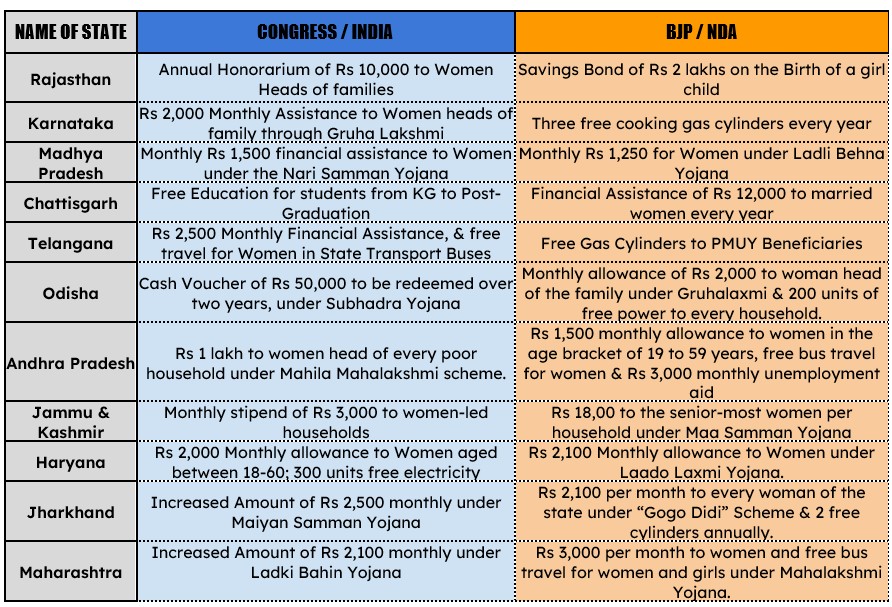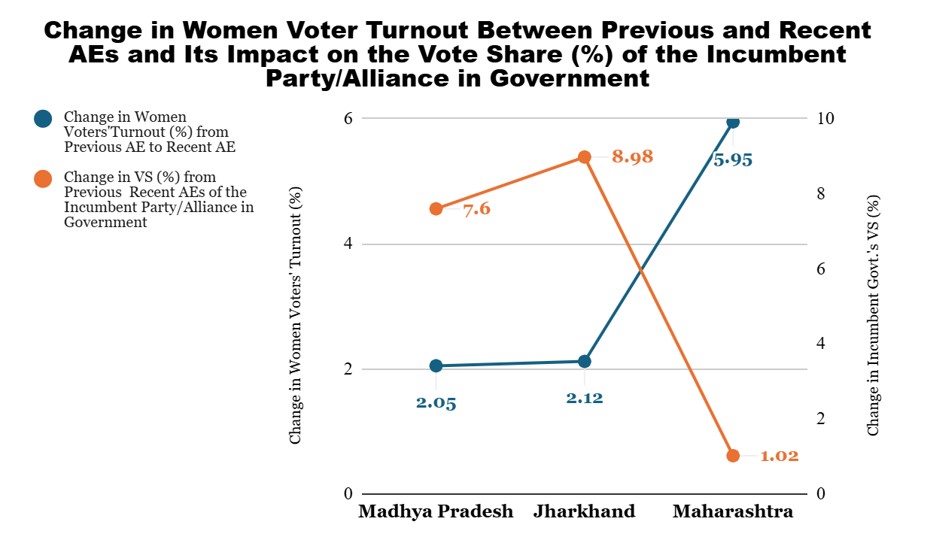In India, the attraction of election-time promises is undeniable. Although the Supreme Court and the RBI, who time and again blow warning horns of revenue deficits and rising debts due to financially unfeasible promises, the political heavy hitters clasp tight more and more “Revdi” culture. As expected, the recent state elections were a whirlwind of promises, with political parties throwing around doles and new schemes all over. From farm loan waivers and government jobs to free education, higher cooking gas subsidies, financial packages for women, laptops for college students, and even a return to the Old Pension Scheme (OPS), every promise was big to make in the race for voter support.

Table 1: Key Examples of Freebies Promised to Different Groups by INC and BJP During State Elections (2023–24)
While The Pradhan Mantri Garib Kalyan Anna Yojana (PM-GKAY), which provides free food grains, addresses immediate nutritional needs and future productivity; measures like free bus services for women can enhance female labor force participation. Similarly, farm loan waivers have a positive impact on consumption demand. These measures, though termed "freebies," have medium- to long-term economic benefits. However, direct cash transfer schemes are meant to only capitalise on the country's voters who earn a daily wage of Rs. 500 per day. This targeted approach to convert a particular socio-economic group into a predictable vote bank is what separates it from welfare measures which are well-integrated into the state budget and are meant to benefit all. For instance, several states have seen higher voter turnout among women following the rollout of financial assistance schemes for underprivileged women ahead of state elections, translating into significant vote share gains. Underprivileged Women voters view it as a sustainable way of fulfilling monthly expenses and pocket money, without understanding that these are mere unsustainable doses of temporary solutions.

Chart 1: 1. The rise in the incumbent party/alliance's (BJP in Madhya Pradesh, INDIA in Jharkhand, and BJP in Maharashtra) vote share (%) shows a strong correlation with the increased turnout of women voters in states where direct cash transfer schemes were implemented towards women beneficiaries during the incumbent's previous tenure. 2. Note - For Maharashtra, only the BJP's vote share has been considered, excluding the Mahayuti alliance.
While schemes like Mamata Banerjee’s Swasthya Sathi and Kanyashree are credited with keeping her in power in West Bengal, political analysts have hailed promises like Gruha Lakshmi in Karnaknata and schemes like Laldi Behen Yojana in Madhya Pradesh to have changed the fates of the political parties in elections. However, freebies are not always guaranteed formulas for winning. In Telangana, K. Chandrashekhar Rao's BRS lost power in the state elections despite promises for increased assistance in the Rythu Bandhu Scheme or Arogya Sri. Similarly, In Rajasthan, the five guarantees and other incentives from the Ashok Gehlot government did not improve the Congress prospects. Even in Andhra Pradesh, YSRCP’s promise to gradually hike welfare pensions from Rs. 3,000 to Rs. 3,500 per month was overshadowed by TDP-JS-BJP’s promise of Rs. 1,500 per month to women, unemployment allowance of Rs. 3,000 per month, and three free gas cylinders per household every year. So, what holds the key? In many cases, it’s competitive populism – where "who gives more" outweighs "who gives what." Just like how the increased value of Rs. 2,500 from Rs. 1,000 under the Maiyan Samman Yojana bogged down the “Gogo Didi Yojana” of Rs 2,100 of the BJP in Jharkhand. Realising the importance of women voters after the Lok Sabha poll, where 87.11 lakh women turned out compared to 83.85 lakh men voters, the Hemant Soren government rolled out this flagship scheme in August. Similarly, the Mahayuti had overwhelming success in Pune, Nashik, Nagpur, Solapur, and Thane, topping the charts in these districts. Interestingly, these were also the districts with the highest number of beneficiaries under the Ladki Bahin Yojana, since its rollout in August, leading to an average 6 per cent increase in women voter turnout compared to the May Lok Sabha polls.

Table 2: The top three districts with the highest beneficiaries of the Ladki Bahin Yojana saw increased women voter turnout than the 2024 Parliamentary Elections and significant seat gains for Mahayuti in the 2024 Assembly Elections.
Apart from the 2024 Lok Sabha elections and a plethora of state elections, the stage is set for upcoming polls in Delhi, Assam, Tamil Nadu, Kerela and West Bengal where populism through freebies is likely to dominate the narrative. However, the question of balancing electoral populism with sustainable fiscal governance looms large. For voters, the onus is on recognizing the long-term impact of these promises, ensuring that incentives today do not compromise development tomorrow.